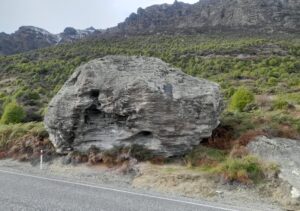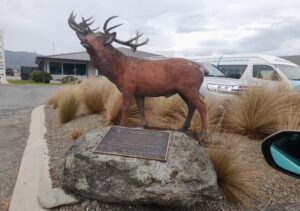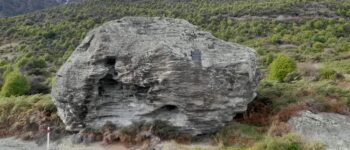1859: Cameron and Macdonald
July 27, 2024
By AHNZ
 South of Queenstown a large boulder is separated from Lake Wakatipu by State Highway 6. It’s a marker for 3 great New Zealand explorers of which 2 became pioneers. All 3 had come over from South Australia on the same ship (Peregrine Oliver,) in order to seek out new sheep country.
South of Queenstown a large boulder is separated from Lake Wakatipu by State Highway 6. It’s a marker for 3 great New Zealand explorers of which 2 became pioneers. All 3 had come over from South Australia on the same ship (Peregrine Oliver,) in order to seek out new sheep country.
For one, Donald Hay, his efforts were not be reciprocated. He explored the Cold Lakes in winter time, braving thunder storms and risking his life. Hay had ice caves to sleep in with icicles hanging down. With a small boat he explored Wakatipu and even used his blanket as a sail. However, upon returning to the Land Office in Dunedin to register his interest he found himself snookered. A land speculator who worked in the Office had already put his own name down for the place and would have been even less inclined to part with it now Hay had proven the value by his leg work. “After only four months in New Zealand he left our shores taking his courage and obvious pioneering spirit with him.” Ref. Scots pioneer subject of novel, ODT (2008,) Press Reader
The other 2 pioneers marked on the face of this boulder had better fortune for their winter explorations. Donald Cameron and Angus Macdonald explored hard too but succeeded in claiming a lease and stocking it. Both pioneer Scotsman lived into their 80s and laid the groundwork for the development of New Zealand’s interior. There were good times coming such as the hungry gold-seekers in the 1860s. But, there were also very hard times such as the Great Snows of 1878.
“The Hector Range, including the Remarkables, east of Lake Wakatipu between Queenstown and Kingston, was foreboding for pioneers. The first known explorers to traverse the lower slopes were Donald Cameron and Angus Macdonald while in search of suitable grazing land in 1858.” – The Story of the Kingston Road, Danny Knudson
“Donald Cameron and Angus Macdonald subsequently received grazing rights to property known as Staircase Station, along the eastern shore of Lake Wakatipu, and Nokomai Station, south of the lake. In order to stock the country, D.A. Cameron and Macdonald purchased 3,592 merino sheep from near Adelaide in South Australia. This mob was brought to Bluff in two ship loads.” – Of Staircase Station 1859 in ‘Donald Hay – Unheralded Hero’ by Danny Knudson
“A link with the very earliest days of settlement in the Mataura Valley and Wakatipu districts was snapped…Cameron died with the Old Year at his home at Nokomai” – Lake Country Press (1919,) Papers Past
“Southland never, never should forget
The men who gave to her the golden years
That spurred her on, we all still owe a debt
To those brave hearts- the Noble Pioneers.
(Adapted from Thomas Bracken)
– The Wanderer, Southland Times (1932,) Papers Past“This High Country station was to be the start of a new clan base for the Camerons, as Donald eventually aquired further stations at Queenstown, Mable Bush near Invercargill and at Tapanui. He became a Justice of the Peace, Chief of Clan Cameron in New Zealand…Without these virtues amongst all our pioneers, none of us would have New Zealand as our country.” – Camerons of the Glen, Donald Offwood (2008)

It’s striking at how high the cost has been to stock our land both in animal life and human.
In crossing the Tasman on 2 trips, and at great expense, 3592 sheep were reduced to only 1259 were landed safely at Bluff. Aboard ship many had died of suffocation from, probably, the residual fumes from their drenching. Only then came the great trek north with poison plants, meat-eating keas, and wild dogs to contend with.
Down the road a bit in Wanaka I was struck by a similar story but this time in the 1960s and concerning deer. Outside Wanaka Airport there is a memorial that states: “Dedicated to the more than fifty pilots, shooters and crew who lost their lives in the mountains and backcountry throughout New Zealand pioneering wild deer recovery from the early 1960s establishing the foundation for the new deer farming industry. Were it not for their bravery and ingenuity, this truly unique New Zealand endeavor to commercially farm deer would not exist as it does today.”
I suspect a lot of Townies simply look at developed industry and land thinking it was always here and not created by our pioneers and settlers. Many probably think the Maoris created it and had it confiscated from them! Or, that the government “built this.” So, I’m grateful to have found a couple of memorials along State Highway 6 that show otherwise.
—
Image ref. Bolder and Deer-catching memorials, AHNZ Archives (2023)
Ref. The Queenstown Courier #84 (2010)
Ref. The Queenstown Courier #82 (2009)
Ref. Donald Angus Cameron & Angus A. Macdonald — Lake Wakatipu, New Zealand, Dunbar Loop, Waymarking.com
3 thoughts on "1859: Cameron and Macdonald"
Leave a Reply
 Like Comment Share
Like Comment Share






We need to take photos of these plaques for future reference as they have been quietly removed from the parks and mountains around Auckland. The plaque on Mt Albert said that the terraces and kumara pits were all done by a people/tribe long before the local tribes arrived. A lot more, I can’t remember now, it was a shock to many to see it gone.
Also removed were donated seats, some with small memorial plaques.
Three Kings human bones: An article in the Herald reproduced a small piece from about 1986…? saying the many tons of human bones,found in caves, were ground up and used as fertiliser, Ngati Whatua said “not our people”. Not certain which newspaper, or the reproduced cutting were in.
Yes, that’s a reason I created this page. To mark history as the Revisionism takes place.
Do you mean this one?
https://ahnz.anarkiwi.co.nz/1907-cavern-of-bones/
Perhaps; at the time I walked my dog on Three Kings almost daily so not sure now.
Mt Albert: On the east side of the hill, below the road, was a fenced off area about grave size, 3x2m, verticle aspect. This was when cattle were grazing the mountain, it was on a very steep part with no sign of a grave marker. I climbed over for a look and came to a guess it was a covered over cave entrance, as in a ‘hole in the ground’. and was fenced off for the cattle. Years later after the TMA took over and the cattle were removed I went looking for the site and surprise, surprise the fence has been removed and I now can only approx find the location, no postholes or old battens were left behind. The fence might show on early aerial photos.